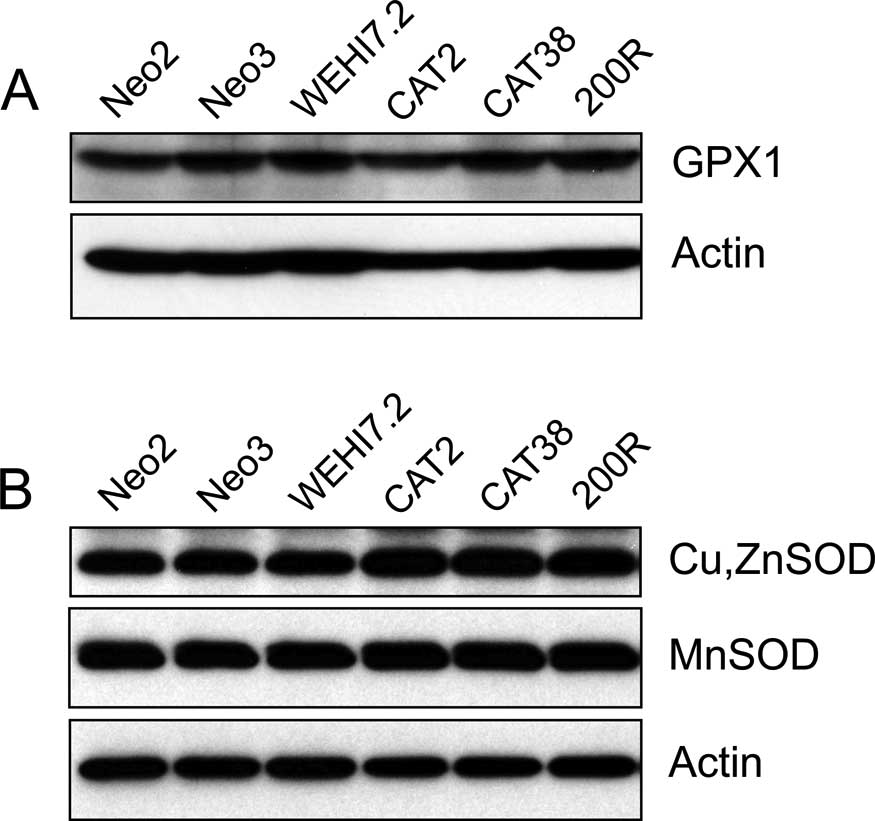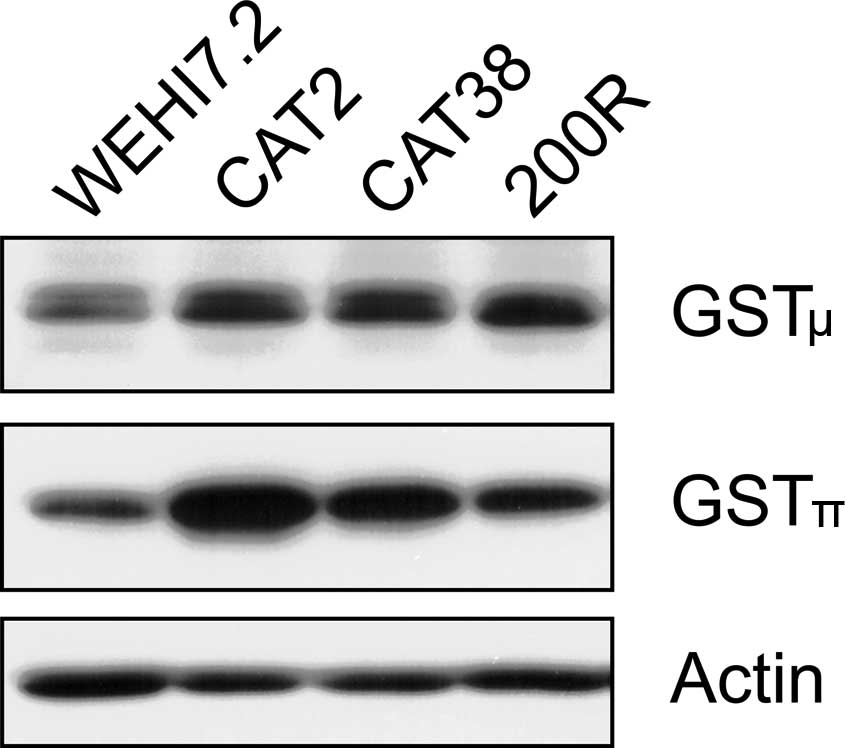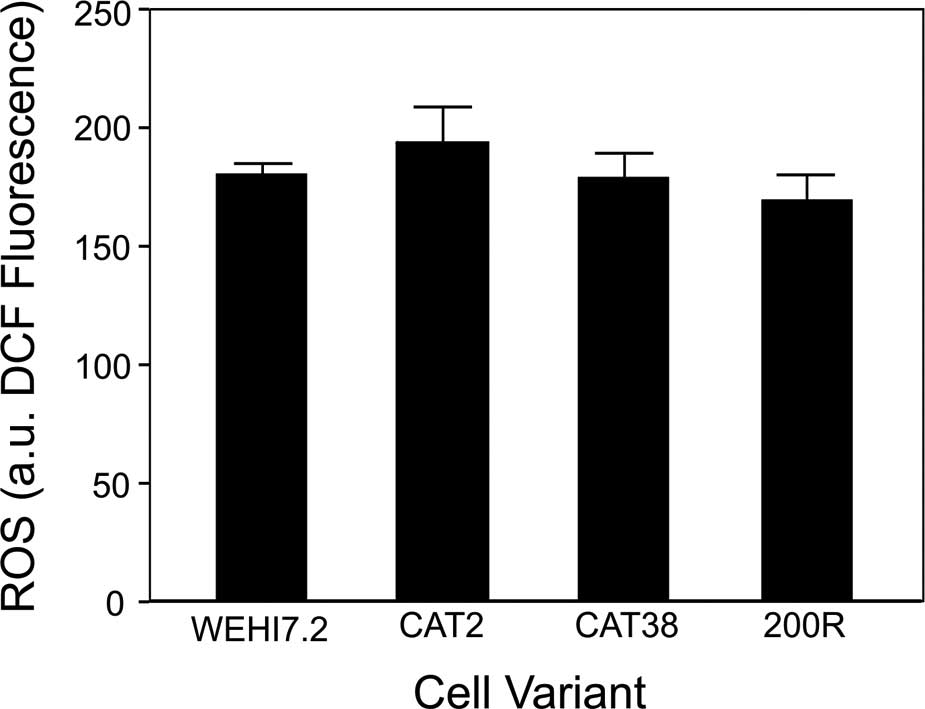|
1.
|
Tavani A, La Vecchia C, Franceschi S,
Serraino D and Carbone A: Medical history and risk of Hodgkin’s and
non-Hodgkin’s lymphomas. Eur J Cancer Prev. 9:59–64. 2000.
|
|
2.
|
Jaffe ES, Harris NL, Stein H and Vardiman
JW: World Health Organization Classification of Tumours: Pathology
and Genetics of Tumours of Haematopoietic and Lymphoid Tissues.
IARC Press; Lyon: 2001
|
|
3.
|
Young LS and Rickinson AB: Epstein-Barr
virus: 40 years on. Nat Rev Cancer. 4:757–768. 2004.PubMed/NCBI
|
|
4.
|
Ramos-Casals M, De Vita S and Tzioufas AG:
Hepatitis C virus, Sjogren’s syndrome and B-cell lymphoma: linking
infection, autoimmunity and cancer. Autoimmun Rev. 4:8–15.
2005.
|
|
5.
|
Gualandi G, Giselico L, Carloni M, Palitti
F, Mosesso P and Alfonsi AM: Enhancement of genetic instability in
human B cells by Epstein-Barr virus latent infection. Mutagenesis.
16:203–208. 2001. View Article : Google Scholar : PubMed/NCBI
|
|
6.
|
Spitz DR, Li GC, McCormick ML, Sun Y and
Oberley LW: Stable H2O2-resistant variants of
Chinese hamster fibroblasts demonstrate increases in catalase
activity. Radiat Res. 114:114–124. 1988.
|
|
7.
|
Cantoni O, Guidarelli A, Sestili P,
Mannello F, Gazzanelli G and Cattabeni F: Development and
characterization of hydrogen peroxide-resistant Chinese hamster
ovary cell variants. I. Relationship between catalase activity and
the induction/stability of the oxidant-resistant phenotype. Biochem
Pharmacol. 45:2251–2257. 1993. View Article : Google Scholar
|
|
8.
|
Tome ME and Briehl MM: Thymocytes selected
for resistance to hydrogen peroxide show altered antioxidant enzyme
profiles and resistance to dexamethasone-induced apoptosis. Cell
Death Differ. 8:953–961. 2001. View Article : Google Scholar : PubMed/NCBI
|
|
9.
|
Tome ME, Baker AF, Powis G, Payne CM and
Briehl MM: Catalase-overexpressing thymocytes are resistant to
glucocorticoid-induced apoptosis and exhibit increased net tumor
growth. Cancer Res. 61:2766–2773. 2001.PubMed/NCBI
|
|
10.
|
Harris AW, Bankhurst AD, Mason S and
Warner NL: Differentiated functions expressed by cultured mouse
lymphoma cells. II. Theta antigen, surface immunoglobulin and a
receptor for antibody on cells of a thymoma cell line. J Immunol.
110:431–438. 1973.
|
|
11.
|
Carlberg I and Mannervik B: Glutathione
reductase. Methods Enzymol. 113:484–490. 1985. View Article : Google Scholar
|
|
12.
|
Ernster L: DT diaphorase. Methods Enzymol.
10:309–317. 1967. View Article : Google Scholar
|
|
13.
|
Tome ME, Johnson DBF, Samulitis BK, Dorr
RT and Briehl MM: Glucose 6-phosphate dehydrogenase overexpression
models glucose deprivation and sensitizes lymphoma cells to
apoptosis. Antioxid Redox Signal. 8:1315–1327. 2006. View Article : Google Scholar : PubMed/NCBI
|
|
14.
|
Efferth T, Briehl MM and Tome ME: Role of
antioxidant genes for the activity of artesunate against tumor
cells. Int J Oncol. 23:1231–1235. 2003.PubMed/NCBI
|
|
15.
|
Tome ME, Jaramillo MC and Briehl MM:
Hydrogen peroxide signaling is required for glucocorticoid-induced
apoptosis in lymphoma cells. Free Radic Biol Med. 51:2048–2059.
2011. View Article : Google Scholar : PubMed/NCBI
|
|
16.
|
Jones DP, Carlson JL, Samiec PS, Sternberg
P Jr, Mody VC Jr, Reed RL and Brown LA: Glutathione measurement in
human plasma. Evaluation of sample collection, storage and
derivatization conditions for analysis of dansyl derivatives by
HPLC. Clin Chim Acta. 275:175–184. 1998.PubMed/NCBI
|
|
17.
|
Jacobson EL and Jacobson MK: Tissue NAD as
a biochemical measure of niacin status in humans. Methods Enzymol.
280:221–230. 1997. View Article : Google Scholar : PubMed/NCBI
|
|
18.
|
Jones DP: Redox potential of GSH/GSSG
couple: assay and biological significance. Methods Enzymol.
348:93–112. 2002. View Article : Google Scholar : PubMed/NCBI
|
|
19.
|
Li JJ, Oberley LW, St Clair DK, Ridnour LA
and Oberley TD: Phenotypic changes induced in human breast cancer
cells by overexpression of manganese-containing superoxide
dismutase. Oncogene. 10:1989–2000. 1995.PubMed/NCBI
|
|
20.
|
Moore DS and McCabe GP: Introduction to
the Practice of Statistics. 4th edition. W.H. Freeman & Co.;
New York: 2003
|
|
21.
|
Myers JL and Well AD: Research Design and
Statistical Analysis. 2nd edition. Lawrence Erlbaum Associates;
Mahwah, NJ: 2003
|
|
22.
|
Schafer FQ and Buettner GR: Redox
environment of the cell as viewed through the redox state of the
glutathione disulfide/glutathione couple. Free Radic Biol Med.
30:1191–1212. 2001. View Article : Google Scholar : PubMed/NCBI
|
|
23.
|
Kirlin WG, Cai J, Thompson SA, Diaz D,
Kavanagh TJ and Jones DP: Glutathione redox potential in response
to differentiation and enzyme inducers. Free Radic Biol Med.
27:1208–1218. 1999. View Article : Google Scholar : PubMed/NCBI
|
|
24.
|
Kirkman HN and Gaetani GF: Catalase: a
tetrameric enzyme with four tightly bound molecules of NADPH. Proc
Natl Acad Sci USA. 81:4343–4347. 1984. View Article : Google Scholar : PubMed/NCBI
|
|
25.
|
Go YM, Gipp JJ, Mulcahy RT and Jones DP:
H2O2-dependent activation of GCLC-ARE4
reporter occurs by mitogen-activated protein kinase pathways
without oxidation of cellular glutathione or thioredoxin-1. J Biol
Chem. 279:5837–5845. 2004.
|
|
26.
|
Talalay P: Chemoprotection against cancer
by induction of phase 2 enzymes. Biofactors. 12:5–11. 2000.
View Article : Google Scholar
|
|
27.
|
Hayes JD and Pulford DJ: The glutathione
S-transferase supergene family: regulation of GST and the
contribution of the isoenzymes to cancer chemoprotection and drug
resistance. Crit Rev Biochem Mol Biol. 30:445–600. 1995. View Article : Google Scholar : PubMed/NCBI
|
|
28.
|
Ahmad IM, Aykin-Burns N, Sim JE, et al:
Mitochondrial O2•− and
H2O2 mediate glucose deprivation-induced
stress in human cancer cells. J Biol Chem. 280:4254–4263.
2005.PubMed/NCBI
|
|
29.
|
Krall J, Bagley AC, Mullenbach GT,
Hallewell RA and Lynch RE: Superoxide mediates the toxicity of
paraquat for cultured mammalian cells. J Biol Chem. 263:1910–1914.
1988.PubMed/NCBI
|
|
30.
|
Esterbauer H, Schaur RJ and Zollner H:
Chemistry and biochemistry of 4-hydroxynonenal, malonaldehyde and
related aldehydes. Free Radic Biol Med. 11:81–128. 1991. View Article : Google Scholar : PubMed/NCBI
|
|
31.
|
Jewell SA, Di Monte D, Richelmi P, Bellomo
G and Orrenius S: tert-Butylhydroperoxide-induced toxicity in
isolated hepatocytes: contribution of thiol oxidation and lipid
peroxidation. J Biochem Toxicol. 1:13–22. 1986. View Article : Google Scholar : PubMed/NCBI
|
|
32.
|
Perry MC, Anderson CM, Dorr VJ and Wilkes
JD: Companion Handbook to the Chemotherapy Source Book. Lippincott,
Williams & Wilkins; New York: 1999
|
|
33.
|
Kamio T, Toki T, Kanezaki R, et al:
B-cell-specific transcription factor BACH2 modifies the cytotoxic
effects of anticancer drugs. Blood. 102:3317–3322. 2003. View Article : Google Scholar : PubMed/NCBI
|
|
34.
|
Matsunaga T, Sakamaki S, Kuga T, et al:
GST-pi gene-transduced hematopoietic progenitor cell
transplantation overcomes the bone marrow toxicity of
cyclophosphamide in mice. Hum Gene Ther. 11:1671–1681. 2000.
View Article : Google Scholar : PubMed/NCBI
|
|
35.
|
McGown AT and Fox BW: A proposed mechanism
of resistance to cyclophosphamide and phosphoramide mustard in a
Yoshida cell line in vitro. Cancer Chemother Pharmacol. 17:223–226.
1986. View Article : Google Scholar : PubMed/NCBI
|
|
36.
|
O’Brien M, Kruh GD and Tew KD: The
influence of coordinate overexpression of glutathione phase II
detoxification gene products on drug resistance. J Pharmacol Exp
Ther. 294:480–487. 2000.PubMed/NCBI
|
|
37.
|
Harbottle A, Daly AK, Atherton K and
Campbell FC: Role of glutathione S-transferase P1, P-glycoprotein
and multidrug resistance-associated protein 1 in acquired
doxorubicin resistance. Int J Cancer. 92:777–783. 2001. View Article : Google Scholar : PubMed/NCBI
|
|
38.
|
Depeille P, Cuq P, Mary S, Passagne I,
Evrard A, Cupissol D and Vian L: Glutathione S-transferase M1 and
multidrug resistance protein 1 act in synergy to protect melanoma
cells from vincristine effects. Mol Pharmacol. 65:897–905. 2004.
View Article : Google Scholar : PubMed/NCBI
|
|
39.
|
Tonomura N, McLaughlin K, Grimm L, Goldsby
RA and Osborne BA: Glucocorticoid-induced apoptosis of thymocytes:
requirement of proteasome-dependent mitochondrial activity. J
Immunol. 170:2469–2478. 2003. View Article : Google Scholar : PubMed/NCBI
|
|
40.
|
Davies KJ: Oxidative stress: the paradox
of aerobic life. Biochem Soc Symp. 61:1–31. 1995.PubMed/NCBI
|
|
41.
|
Gewirtz DA: A critical evaluation of the
mechanisms of action proposed for the antitumor effects of the
anthracycline antibiotics adriamycin and daunorubicin. Biochem
Pharmacol. 57:727–741. 1999. View Article : Google Scholar : PubMed/NCBI
|
|
42.
|
Trevino AV, Woynarowska BA, Herman TS,
Priebe W and Woynarowski JM: Enhanced topoisomerase II targeting by
annamycin and related 4-demethoxy anthracycline analogues. Mol
Cancer Ther. 3:1403–1410. 2004.PubMed/NCBI
|
|
43.
|
Shacter E, Williams JA, Hinson RM,
Senturker S and Lee YJ: Oxidative stress interferes with cancer
chemotherapy: inhibition of lymphoma cell apoptosis and
phagocytosis. Blood. 96:307–313. 2000.PubMed/NCBI
|
|
44.
|
Murata M, Suzuki T, Midorikawa K, Oikawa S
and Kawanishi S: Oxidative DNA damage induced by a hydroperoxide
derivative of cyclophosphamide. Free Radic Biol Med. 37:793–802.
2004. View Article : Google Scholar : PubMed/NCBI
|
|
45.
|
Huang Y, Fang Y, Wu J, Dziadyk JM, Zhu X,
Sui M and Fan W: Regulation of Vinca alkaloid-induced apoptosis by
NF-kappaB/IkappaB pathway in human tumor cells. Mol Cancer Ther.
3:271–277. 2004.PubMed/NCBI
|
|
46.
|
Adler V, Yin Z, Fuchs SY, et al:
Regulation of JNK signaling by GSTp. EMBO J. 18:1321–1334. 1999.
View Article : Google Scholar : PubMed/NCBI
|
|
47.
|
Townsend DM and Tew KD: The role of
glutathione-S-transferase in anti-cancer drug resistance. Oncogene.
22:7369–7375. 2003. View Article : Google Scholar : PubMed/NCBI
|
|
48.
|
Hosono N, Kishi S, Iho S, et al:
Glutathione S-transferase M1 inhibits dexamethasone-induced
apoptosis in association with the suppression of Bim through dual
mechanisms in a lymphoblastic leukemia cell line. Cancer Sci.
101:767–773. 2010. View Article : Google Scholar : PubMed/NCBI
|

















